Features of extension cords on a reel

For the operation of electrical appliances, it is necessary to connect to a stationary power source, but if it is at a remote distance, an extension cord will help to solve the problem, the wire of which is wound on a coil for ease of use. A portable power extension cord on a reel is an indispensable assistant when performing work at a summer cottage, at a construction site or in other cases where the length of the electrical appliance cord to a stationary outlet is clearly not enough.

Description and general characteristics
An extension cord on a coil is a device that is used to transfer electrical voltage from a power source to an electrical appliance. The design of such a device can have several sockets and, depending on the cable cross-section, it can be used to connect several devices at once.
A portable extension cord with a long length of the electric cable is wound on a reel, thanks to which the cord can be quickly unwound to the desired length or returned to its original position. Modern portable extension cords are equipped with a power on / off button, have built-in automatic relays and thermal switches, and are also equipped with automatic cable retraction systems and a button to fix it at a certain length during operation.



An electric cable wound into a coil is convenient to use in work - excess wires do not get tangled underfoot and do not form nodal weaves, which over time damage the power cord and can lead to a short circuit. The power cord is easy to carry or store, it does not take up much space when coiled.
An extension cord on a reel, as a rule, has 3 or 4 sockets into which you can connect different electrical appliances. But the connection depends on the power of these devices and the cross-section of the extension cable. The minimum cross-section must be at least 1.5 mm², it can withstand a current load of 16 amperes, that is, 3.5 kilowatts.
Most portable reel extension cords have an automatic circuit breaker that protects the device against overvoltage and short circuits that occur when an excessive electric current is present.

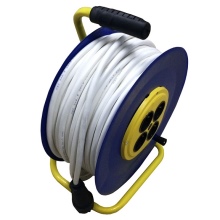

What are they?
An electrical extension cord on a coil has various design features, depending on which these devices are divided into types.
- Carrying extension cord. Its length is 30 meters, but there are models of 10 m, 20 m, 25 m, 40 m or 50 m. The drum extension cord can weigh 15-20 kg on average, sometimes it is made on a metal stand. The device is used for household and industrial needs. Power is supplied from a 220 V network.
- An extension cord with a collapsible body. This is a reel-to-reel type of device, the body of which is fastened with bolts or self-tapping screws and, if necessary, repairs can be disassembled to replace the wire or plug.
- Non-separable reel extension. It is made as a single system that contains a cable, an electrical plug and 4 sockets. The plug is fixed to the cable by crimping and cannot be repaired. If the cable breaks from the coil, the device becomes unusable for further use.
- Extension cord with electrical protection. The device in the housing has additional protective insulation of conductive elements from accidental contact with them. The protection is durable and does not deteriorate during operation.The electric cable of such extension cords is double insulated. In addition, the design of such an extension cord is based on an automatic surge protector system, which cuts off the power supply in case of excessive electric current.
- Extension cord with grounding. Some models have a grounding contact, which guarantees the protection of a person from electric shock and increases the safety of the device.
- Extension cord with protection of the structure from external influences. The sockets have special covers that cover the points of contact with the plug from moisture. In addition, there are extension cords, the electrical cable of which is frost-resistant, that is, it does not lose its flexibility at negative temperature conditions. The temperature operating mode is indicated in the passport for the device, high-quality models equipped with good double insulation can work even in frost at -30-40 ° C.



In addition to conventional coil-to-reel extension cords, there is also a power professional version, which is used at construction sites and is connected to a 380 volt voltage network. The length of such devices can reach 100 m. Electrical appliances are connected to the power extension cord, the power of which starts from 3 kW; in domestic conditions, equipment does not have such parameters. Thanks to the long cord, the reel-type power extension cord is used both indoors and outdoors.
The power extension cord has double insulation of the electric cable, it is reliably protected from moisture and has sockets with additional protection against electric shock to a person. The use of a power extension cord depends on the cross-section of its cord.
Such data are available on the cable marking and indicate the maximum possible degree of power load of electrical appliances connected through an extension cord.
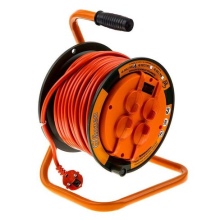


According to the cross-section of the wire, types of extension cord are distinguished.
- The cross-section of 0.75 mm² is intended for an electric current load of 6 A. The device is suitable only for household appliances of low power.
- A cross section of 1mm² is designed for an electric current load of 10 A. The device is suitable for household appliances and small low-power construction tools.
- The cross-section of 1.5 mm² is designed for a load of no more than 16 A. The device is intended for construction tools in household use.
- The cross-section of 2.5 - 120 mm² is intended for industrial and construction applications in order to connect powerful equipment in terms of its loads.
Unlike a household extension cord, professional power structures have a cable consisting of 3 cores.
The insulation of the power extension cord is always only double, and the power plug must be grounded.



How to choose?
When choosing a portable drum extension cord, professionals recommend paying attention to several important nuances.
- Number of socket-outlets. On average, there are 3-4 of them, but there are models where there can be 1 outlet or 7 pieces at once. Several sockets on an extension cord are convenient in that several electrical appliances can be connected at the same time, but their total power consumption must be taken into account.
- Grounding contact. The presence of this element in the device prevents a person from being hit by an electric shock. Such a probability can happen with a faulty power strip or an electrical appliance that is connected to it. In addition, grounding eliminates interference in the power grid and extends the life of electrical appliances.
- The length of the electrical cable. Drum-type devices have a cable length of 30 m. This option is more common, but you can find models with a longer cord. The length of the cord depends on the needs that are associated with connecting devices during operation. When connecting equipment with a power equal to the power of the electric cable, it is recommended to unwind it to its full length during operation.This is done so that the cable does not overheat, since during operation an induction field is formed around the cord, which causes the cord to heat up. Only complete unwinding will save it from overheating. In cases where the power of the connected device is equal to half the power of the cable load, during operation the cord does not need to be completely unwound.
- Device power. Each extension cord, depending on the cross-section of its electrical wire, can only work with devices of a certain power, which cannot be exceeded. If several devices are connected to the extension cord at once, then their total power is considered and compared with the operating power of the device.
- The presence of a circuit breaker. This option, built into the construction of the extension cord, protects it from voltage surges that often occur in a stationary power supply network. A surge in electrical voltage can lead to a short circuit, and if the supply of electricity is not stopped in time, the tools connected to the extension cord will fail. Automatic protection prevents such situations and prevents overloads in time.
- Electrical cable insulation. It can be simple one-layer or two-layer. Simple insulation on an extension cord is used in a domestic environment where there are no temperature extremes and high humidity. In more difficult conditions, for example, when working outside, in the cold, it is necessary to use an electric extension cord with only two-layer insulation.



Some models of the reel extension can be equipped with additional options that are not necessary, but create convenience in operation. For example, it can be a power-on indicator that allows you to see if the extension cord is connected to the power supply or not.
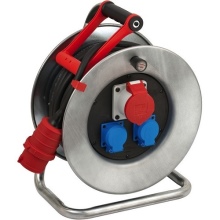

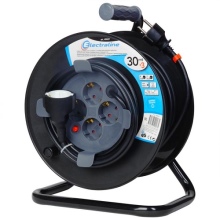
How to use it correctly?
In the process of using an extension cord, it is important to know and follow safety precautions. If the device has damage to the case, power plug or electric wire, then it is prohibited to use it for work. If sparking is observed when the plug is connected to the network, this indicates that the terminals of the clips in the extension cord are loose, and you cannot use it until this problem is eliminated.
You can only connect the extension cord to an electrical outlet with a working electrical plug. A drum with a wound wire must be placed only in a dry place, and to prevent damage to the integrity of the electrical cable, it must be placed in places where there is no movement of vehicles or people.


Basic rules for using an extension cord:
- it is not recommended to change the design of the device and improve it;
- an extension cord is not used for permanently connecting devices to the mains, they only serve for short-term connection at the time of performing the necessary work;
- the device is not used if it or the electrical outlet has obvious or hidden damage;
- a faulty electrical wire must be completely replaced;
- it is forbidden to tie knots on the electrical wire, pinch it with building materials or clamps;
- the power cable must not be installed under the floor covering, or under the threshold or above the threshold of the door frame.
Before plugging the extension cord into an electrical outlet and connecting electrical appliances to it, it is necessary to assess the power of the electric current load. Such a preliminary assessment is necessary both in the case of connecting 1 device, and several at once. The total power of the connected electrical appliances should not be higher than the power of the extension cord specified in its passport.
Failure to comply with this requirement may result in a short circuit and fire in the electrical cable.

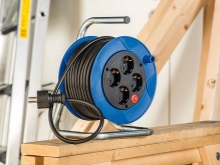
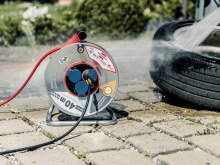
You can learn how to properly use the extension cord on the reel from the video below.













The comment was sent successfully.